Western Digital Caviar Green 3TB and My Book Essential 3TB Drives Reviewed
by Anand Lal Shimpi on October 19, 2010 1:43 PM EST- Posted in
- Storage
- HDDs
- Western Digital
- 3TB
Overall System Performance using PCMark Vantage
Next up is PCMark Vantage, another system-wide performance suite. For those of you who aren’t familiar with PCMark Vantage, it ends up being the most real-world-like hard drive test I can come up with. It runs things like application launches, file searches, web browsing, contacts searching, video playback, photo editing and other completely mundane but real-world tasks. I’ve described the benchmark in great detail before but if you’d like to read up on what it does in particular, take a look at Futuremark’s whitepaper on the benchmark; it’s not perfect, but it’s good enough to be a member of a comprehensive storage benchmark suite. Any performance impacts here would most likely be reflected in the real world.
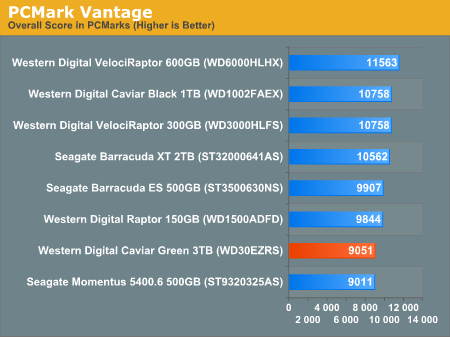
PCMark Vantage shows us the real world performance of the 3TB Caviar Green isn't so great if you're using it as a boot/application drive. The HDD specific suite is particulary troublesome as the drive is barely faster than Seagate's 2.5" 5400.6.
The memories suite includes a test involving importing pictures into Windows Photo Gallery and editing them, a fairly benign task that easily falls into the category of being very influenced by disk performance.
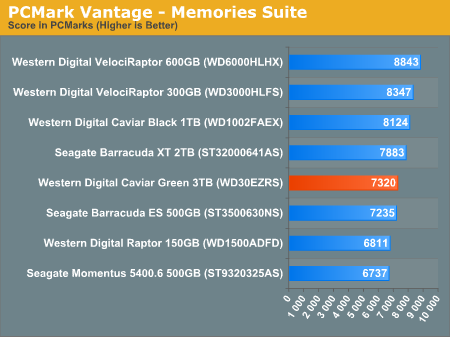
The TV and Movies tests focus on on video transcoding which is mostly CPU bound, but one of the tests involves Windows Media Center which tends to be disk bound.
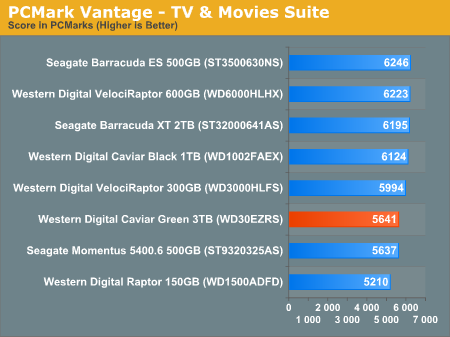
The gaming tests are effectively read tests since they spend a good portion of their time focusing on reading textures and loading level data. Actual game loading performance will differ depending on the game. Take these results as a best case scenario of what can happen, not the norm.
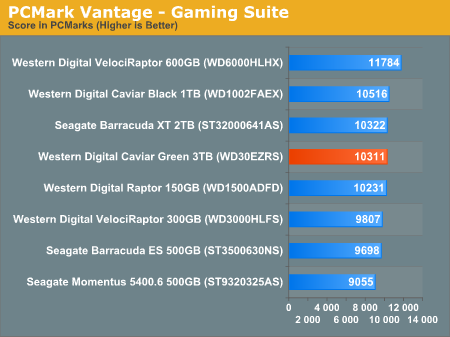
In the Music suite the main test is a multitasking scenario: the test simulates surfing the web in IE7, transcoding an audio file and adding music to Windows Media Player (the most disk intensive portion of the test).
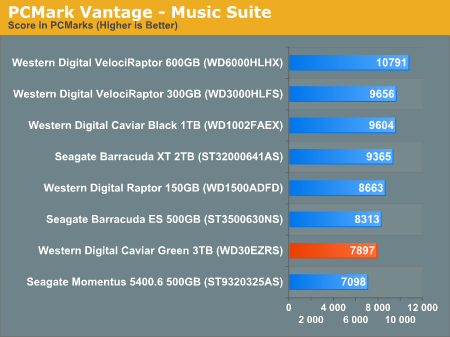
The Communications suite is made up of two tests, both involving light multitasking. The first test simulates data encryption/decryption while running message rules in Windows Mail. The second test simulates web surfing (including opening/closing tabs) in IE7, data decryption and running Windows Defender.
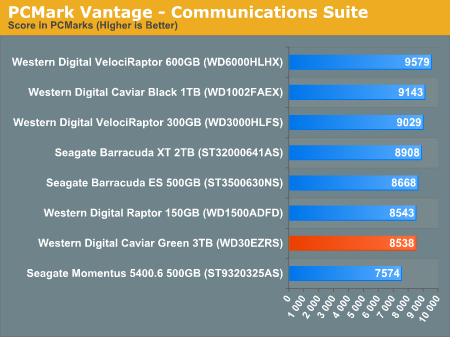
I love PCMark's Productivity test; in this test there are four tasks going on at once, searching through Windows contacts, searching through Windows Mail, browsing multiple webpages in IE7 and loading applications. This is as real world of a scenario as you get and it happens to be representative of one of the most frustrating HDD usage models - trying to do multiple things at once. There's nothing more annoying than trying to launch a simple application while you're doing other things in the background and have the load take forever.
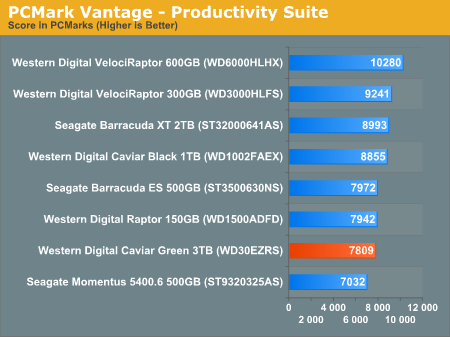
The final PCMark Vantage suite is HDD specific and this is where you'll see the biggest differences between the drives:
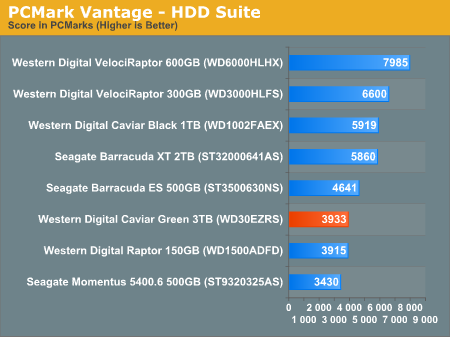










48 Comments
View All Comments
mapesdhs - Wednesday, October 20, 2010 - link
I've been buying Samsung drives for a while, they are indeed pretty quick. I've
not compared to Seagate or WD, but I've added some Samsung HDTach data to
my benchmarks page for the 1TB editions of the Spinpoint F1 and F3, if it's of
any use:
http://www.sgidepot.co.uk/diskdata.html
At some stage I'd like to start testing random read/write with IOMeter, but finding
the time is a problem.
Ian.
EddyKilowatt - Tuesday, October 19, 2010 - link
Exactly. I think the fast/high performance end of the magnetic storage market will wither pretty fast under the onslaught of SSDs, except for increasingly niche applications that need fast access to 500-1000 MB of data.Meanwhile, as SSDs get solidified in the fast boot/app/cache role, the need for speed will further be relaxed for these big TB-class drives, and disk builders will feel freer to optimize for areal density at the expense of speed. I think we'll see lots of 5400 drives, and who knows... maybe 4200 and other speeds that till now have seemed like grandma territory. Anything that can originate a couple of full-HD video streams, or other media stream of your choice, seems like it ought to be viable for what will increasingly be the foundation tier of the ever-diversifying storage hierarchy.
AFUMCBill - Tuesday, October 19, 2010 - link
"The Essential suffix somehow implies USB 3.0 support."This is incorrect. The Essential suffix means USB only support, no eSATA, no FireWire. That USB support can be either USB 2.0 or USB 3.0.
kepstin - Tuesday, October 19, 2010 - link
It's not actually true that a classic PC BIOS can't boot from a GPT formatted disk - I'm doing that right now!The design of GPT incorporates backwards compatibility, including space for an old-fashioned MBR boot sector that can be loaded with a bootloader that knows how to read GPT. As a result, Linux boots just fine on a GPT partitioned disk, even on a classic BIOS PC.
The issue is specifically that Windows can't boot off of a GPT disk without EFI, because the boot loader that Windows uses on a BIOS machine doesn't know how to read GPT partitions.
Mr Perfect - Wednesday, October 20, 2010 - link
Can it read more then 2TB? I read it to mean that BIOS couldn't handle anything bigger then 2TB, regardless.Etern205 - Wednesday, October 20, 2010 - link
On page 2 , one of the images show a MBR partition HDD can be converted to GPT.If one has all the requirements, can they just use their OS disc to directly create a GPT partition instead of doing this conversion stuff?
R3MF - Wednesday, October 20, 2010 - link
Anand - will there be 2TB green drives based on these platters?tiro_uspsss - Wednesday, October 20, 2010 - link
there is no 150GB VelociRaptor in the benches/review.. ;)mapesdhs - Wednesday, October 20, 2010 - link
Here's what I get with HDTach for my WD VR 150GB:
Max: 132.0 MB/sec
Avg: 107.0 MB/sec
Min: 79.0 MB/sec
Burst: 248.0 MB/sec
Access: 6.9ms
Ref: http://www.sgidepot.co.uk/diskdata.html
What does IOMeter use as its definition of 1MB? 10^6 bytes or 2^20 bytes? I think
HDTach uses the former.
Ian.
Mr Perfect - Wednesday, October 20, 2010 - link
I've seen a number of sites now mentioning UEFI will show up in H1 of 2011. Is UEFI an official feature of the Cougar Point chipsets?